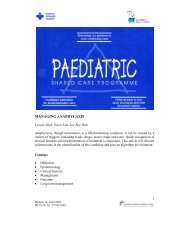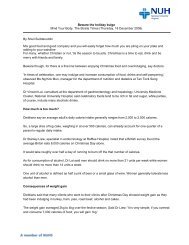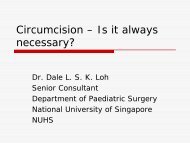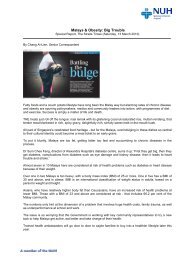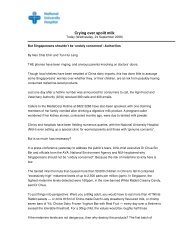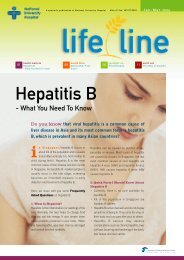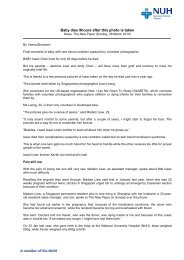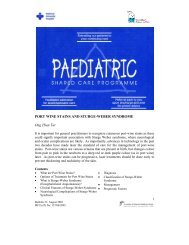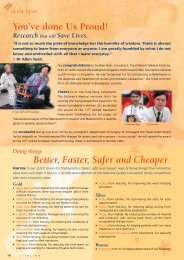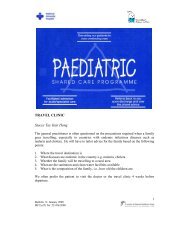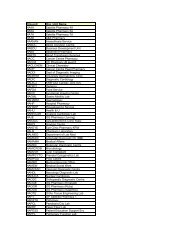COLORECTAL CANCER - NUH
COLORECTAL CANCER - NUH
COLORECTAL CANCER - NUH
Create successful ePaper yourself
Turn your PDF publications into a flip-book with our unique Google optimized e-Paper software.
<strong>COLORECTAL</strong> <strong>CANCER</strong><br />
Dr LIM Li Lin<br />
Senior Consultant<br />
Dept of Gastroenterology & Hepatology<br />
National University Hospital
Cancer Incidence in Singapore<br />
1993-97 1993 97<br />
Males Females<br />
Lung 3,158 Breast 3,574<br />
Colorectal 2,570 Colorectal 2,329<br />
Stomach 1,435 Lung 1,443<br />
Liver 1,296 Cervix 1,126<br />
NPC 1,121 Stomach 927<br />
Prostate 903 Ovary 880<br />
Singapore Cancer Registry
Cancer Incidence in Singapore<br />
1998-2002 1998 2002
Colorectal cancer (CRC) is:<br />
- the commonest cancer in Singapore among men<br />
- the second commonest cancer in Singapore among<br />
women<br />
The average population risk for developing colorectal cancer<br />
in Singapore is among the highest in the world<br />
The age-standardized rates (ASR) for the period 2002-2006<br />
was:<br />
MEN - 40.2 per 100,000 per year<br />
WOMEN – 28.8 per 100,000 per year<br />
Sources: S’p Cancer Registry Interim Report, Trends in Cancer Incidence in S’p 2002-2006<br />
JS Byeon, et al, Gastrointest Endosc, 2007;65:1015-22<br />
Sung JJY et al, Lancet Oncol, 2005;6:871-76<br />
Sung JJY, Cancer Detection & Prevention, 2007;31:1-2
Source: Sung JJY et al,<br />
Lancet Oncol, 2005;6:871-76
Progression from polyp to cancer
Colon polyp
Colon Cancer
Colon polyp Snaring of polyp After polypectomy
Distribution
Disease Distribution<br />
Rectum 12 16.7 }<br />
Sigmoid<br />
colon<br />
13 18.1 }<br />
Descending 11 15.3 }<br />
Transverse 10 13.9 ]<br />
Ascending 16 22.2 ]<br />
Hepatic<br />
flexure<br />
2 2.7 ]<br />
Caecum 8 11.1 ]<br />
L-sided sided 50.1%<br />
R-sided sided 49.9%
Risk Factors
Risk Factors<br />
1. Personal history / risk<br />
2. Family history / risk<br />
3. Polyp type / features
1. Personal history and CA risk<br />
Personal history of CA<br />
–<br />
1.5-3% 1.5 3% cancer risk in 5 years<br />
Size of Polyp >1cm, multiple polyps<br />
and villous & tubullovillous polyp<br />
–<br />
Risk Factors<br />
RR 3.5-6.5 3.5 6.5<br />
Single small polyp –RR RR not increased
2. Family history of polyps & CA risk<br />
1° relative with polyp -<br />
(1.1-2.67) (1.1 2.67)<br />
��Siblings Siblings with polyp<br />
-<br />
Risk Factors<br />
RR 2.59 (1.46-4.58) (1.46 4.58)<br />
RR 1.78<br />
before 60<br />
cf siblings with polyps polyps<br />
after 60<br />
Data from the US national polyp study
3. Family history of CA and CA risk<br />
Relative risk (95%CI)<br />
Age adjusted<br />
One 1° relative with CA 1.72 (1.34 – 2.19)<br />
Age 65 1.09 (0.52-2.28)<br />
Two 1° relative with CA 2.75 (1.34-5.63)<br />
One 1° relative
Polyp type / features<br />
Classifications of polyps and CA risk<br />
Polyps: Tubular, Tubulovillous, Villous<br />
Dysplasia:<br />
-Mild, Mild, Moderate dysplasia<br />
-High High-grade grade / Severe dysplasia<br />
Polyp size:Large >1.0cm increased risk<br />
7.7x
Clinical Manifestations<br />
Abdominal pain —<br />
Change in bowel habit —<br />
Hematochezia or melena —<br />
Weakness —<br />
44 %<br />
43 %<br />
40 %<br />
20 %<br />
Anemia without other gastrointestinal<br />
symptoms —<br />
11 %<br />
Weight loss —<br />
6 %
Signs<br />
Abdominal mass on examination<br />
Low red blood cell (hemoglobin)<br />
count / Anemia -<br />
pale<br />
Blood in stools on anal examination<br />
Palpable anal mass on anal digital<br />
examination
Investigations<br />
Total Colonoscopy-<br />
FBC<br />
Pre-operative Pre operative CEA<br />
LFT<br />
synchronous lesions<br />
CT abdomen & pelvis<br />
CXR<br />
Assess for Cardio-respiratory Cardio respiratory fitness
Stage Duke’s Duke s 5-year year survival %<br />
A (Limited to bowel wall)<br />
B (Through bowel wall)<br />
C (Regional nodes)<br />
STAGING-Duke’s<br />
D (Distant metastases)<br />
94.3<br />
84.4<br />
56.5<br />
2.4
STAGING-TNM<br />
Stage I (T1-2N0) (T1 2N0)—<br />
Stage IIA (T3N0) —<br />
Stage IIB (T4N0) —<br />
Stage IIIA (T1-2 (T1 2 N1)— N1)<br />
Stage IIIB (T3-4 (T3 4 N1) —<br />
Stage IIIC (N2) —<br />
Stage IV —<br />
5-year survival %<br />
93 %<br />
85 %<br />
72 %<br />
83 %<br />
64 %<br />
44 %<br />
8 %
Treatment<br />
Surgical resection with end-to end to-end end<br />
anastomosis (permanent colostomy)<br />
Adjuvant chemotherapy -5FU/fluorouracil 5FU/fluorouracil &<br />
levamisole in Dukes’ Dukes C (TNM stage III)<br />
ie lymph node +ve<br />
– reduced risk of CRC recurrence by 42%<br />
- reduced overall death rate by 33% cf<br />
surgery alone<br />
Palliative chemotherapy for advanced<br />
disease-<br />
disappointing, 5FU & high-dose high dose<br />
leucovorin
Post-surgery Post surgery Follow up<br />
80% of recurrences after CRC resection occur<br />
within the first 2 years post-surgery<br />
post surgery -therefore therefore<br />
more intensive follow up during this period<br />
Colonoscopy surveillance 3-5yearly 3 5yearly<br />
-5-10% 10% of pts dev metachronous tumours<br />
CEA<br />
Liver imaging<br />
-No No final survival advantage demonstrated by<br />
randomized studies as of yet
Metastasis<br />
15 to 20 % pts have distant metastatic disease at<br />
the time of presentation.<br />
CRCs can spread by<br />
-lymphatic lymphatic<br />
-hematogenous hematogenous dissemination, as well as by -<br />
contiguous and transperitoneal routes.<br />
Most common metastatic sites<br />
–<br />
–<br />
regional lymph nodes<br />
Liver -10 10-25%pts 25%pts<br />
– lungs<br />
– Peritoneum<br />
Patients may present with signs or symptoms referable to<br />
any of these areas.
Screening….WHY Screening .WHY SCREEN?<br />
Common and lethal<br />
Long asymptomatic interval<br />
Adenoma-carcinoma Adenoma carcinoma sequence 10-15 10 15 years<br />
Polyp dwell time<br />
–Low Low rate of adenoma progression<br />
to Ca: 2.5 polyps /1000/ year.<br />
Safe, effective, feasible screening tests<br />
available<br />
Early detection & treatment improves survival<br />
Benefits from screening outweigh risks or<br />
adverse effects
Screening Recommendations<br />
Population-based Population based screening of AVERAGE<br />
RISK individuals (AGA, ACG, ACS etc)<br />
Start at 50 yo, stop at 85 yo<br />
1. Annual FOBT >50 yo<br />
and / or<br />
2. Colonoscopy every 10 years<br />
3. Flexible sigmoidoscopy every 5 yrs<br />
3.<br />
4.<br />
>50 50 yo<br />
A positive screen is an indication for colonoscopy<br />
4. DCBE every 5-10 5 10 years
1��<br />
Current Recommendations<br />
High risk groups<br />
relative<br />
Large<br />
with CRC
Colorectal Cancer Screening in Singapore<br />
Government policies<br />
MOH Singapore<br />
Clinical Practice Guidelines<br />
• Endorses colorectal cancer<br />
screening<br />
• Recommendations for<br />
� Average risk<br />
� High risk<br />
� Very High risk groups<br />
• Clinical care eligible for public<br />
subsidies
Screening for Colorectal Cancer<br />
Clinical Practice Guidelines, Ministry of Health<br />
Singapore<br />
Risk Group Screen Tool Onset Freq Evidence Grade<br />
Average Risk FOBT 50 Annually Ia A<br />
Fl sigmoidoscopy 50 Every 5y IIa B<br />
Colonoscopy 50 Every 10y IIb B<br />
Barium enema 50 Every 5-10y IV C<br />
High Risk<br />
1. CRC in 1 st deg relative45 Colonoscopy 10y prior Every 10y IIb B<br />
3. Personal hx colon polyps Colonoscopy 3y (hi risk) or 5y (lo risk) Ib A<br />
4. Pers hx colorectal cancer Colonoscopy 1y after resection IIa B<br />
5. Pers hx of ovarian/endometrial ca Colonoscopy 1y after resection IV C<br />
Very high risk<br />
1. FH FAP Fl sigmoid, 12-14y Annually IIb B<br />
genetic testing<br />
2. FH HNPCC Colonoscopy, 10y prior Every 2y IIb B<br />
genetic testing<br />
3. IBD Colonoscopy 15y (left-c) or 8y (pan) IIb B
FOBT kit (Haemoccult Sensa / HOS)<br />
Guiaic based
FOBT kit
Immunochemical FOBT (IFOBT)<br />
Antibody to human Hb<br />
IFOBT is more specific and<br />
does not require dietary<br />
restrictions<br />
-FOBT FOBT : 3 consecutive sample collection<br />
-IFOBT IFOBT : 2 consecutive sample collection
IFOBT kit
1. FOBT<br />
• RCT Minnesota<br />
EVIDENCE<br />
• Follow up 13 yrs. Mainly rehydrated specimens<br />
Freq 13yr cum †/1000 † reduction %<br />
Annual 5.88 33 Signif<br />
Biennial 8.33 6 NS<br />
Control 8.83<br />
Mandel JS et al NEMJ 93;328:1365-71
EVIDENCE<br />
RESULTS OF FOBT TRIALS<br />
STUDY N Mortality Survival<br />
Minnesota 46,551 36% Improved<br />
New York 12,479 43% Improved<br />
Denmark 61,993 18% Improved<br />
England 150,251 15% Improved<br />
33%<br />
Sweden 68,308 Improved
Flexible Scope
Scope room setup
Colonoscopy<br />
Risks / Complications<br />
��0.1 0.1 –<br />
0.3% intestinal perforation<br />
��0.1% 0.1% bleeding<br />
��0.01% 0.01% mortality / death
COLONOSCOPY<br />
National Polyp Study<br />
1418 pts colonoscopy: ��1 1 adenoma, no prior<br />
polypectomy.<br />
polypectomy.<br />
F-up up 5.9 years-97% years 97% pts, 8401 person-yrs person yrs<br />
76% reduced incidence of<br />
CRC by colonoscopic<br />
removal of polyps<br />
Winawer SJ et al. NEMJ 1993; 329: 1977- 1977<br />
1981
COLONOSCOPY<br />
�� Canadian study: Database of nearly 2.4 million<br />
patients who were undergoing colonoscopy and<br />
looked at cancer reduction.<br />
�� They showed that for every 1% increase in<br />
utilization of colonoscopy<br />
�� there was a 3% reduction in colon cancer<br />
death.<br />
Rabeneck<br />
L, Paszat<br />
LF, Saskin<br />
R, et al. Association between colonoscopy<br />
rates and colorectal cancer mortality. Am J Gastroenterol. Gastroenterol.<br />
2010;105:1627-<br />
2010;105:1627<br />
1632.
Normal DCBE
Polyps – 2 polyps
Cancer<br />
– large irregular filling<br />
defect, extent of tumour indicated<br />
by arrows
Colorectal Cancer Screening in Singapore<br />
Which Screening Test for<br />
Population screening ?<br />
Cost-effectiveness analysis using decision model<br />
Target population 50-70y, 495,000 people<br />
Screening<br />
FOBT<br />
Flex Sig<br />
Colonoscopy<br />
DCBE<br />
+<br />
-<br />
+<br />
-<br />
+<br />
-<br />
+<br />
-<br />
Colonoscopy<br />
FOBT annually<br />
Rpt Flex Sig 3y<br />
Rpt Colonoscopy 10y<br />
Rpt DCBE 5y<br />
Yeoh
Simulation Model for Population screening in Singapore<br />
Target population<br />
50-70y, n=495,000<br />
4950<br />
4950<br />
2%<br />
FOBT + ve<br />
Colonoscopy<br />
Offered FOBT screening<br />
FOBT uptake<br />
Compliance assumed 50%<br />
FOBT - ve<br />
Annual FOBT<br />
242550<br />
50% 10% 30% 10% 10% 0.3% 0.3%<br />
Normal<br />
Annual<br />
FOBT<br />
Adenoma<br />
>1cm<br />
Small<br />
polyp Cancer Incomplete<br />
Complication,<br />
Minor eg bleeding<br />
2475 495 1485 495 495 15 5<br />
Yeoh<br />
Colonoscopy 3yrly<br />
Surgery /<br />
Other Rx<br />
Barium<br />
enema<br />
Total cost $7,593,400<br />
Hospitalisation 1/7<br />
Transfusion<br />
Complication,<br />
Major eg perf<br />
Hospitalisation 4/7<br />
Laparotomy<br />
0.1% 1<br />
Death
Colorectal Cancer Screening in Singapore<br />
Which Screening Test is Cost-Effective ?<br />
Cost-effectiveness analysis using decision model<br />
Conclusions :<br />
FOBT has the lowest cost-per-life year<br />
gained<br />
Calculated cost S$ 2,681,008 (20% compliance )<br />
S$8,043,024 (60% compliance )
Colorectal Cancer Screening in Singapore<br />
Population Awareness of CRC in Singapore<br />
Population survey 2000 adults<br />
1000 tel (85% compliance), 1000 mail (21.5% compliance),<br />
1067 respondents<br />
20 questions on knowledge of disease,<br />
symptoms, screening<br />
Eg<br />
“What What tests are available to detect colorectal cancer ? “<br />
“What What are the symptoms of Colorectal Cancer ?“ ?<br />
Wong NY et al. Adults in a high risk area are unaware of the<br />
importance of Colorectal cancer. Dis Colon Rectum 2002; 45:946
Colorectal Cancer Screening in Singapore<br />
Population Awareness of CRC in Singapore<br />
Awareness of screening as a important measure :<br />
T 11%, M 35.8%<br />
Unable to name even one symptom of CRC :<br />
T 46.5%, M 34.9%<br />
Poor general knowledge on CRC and screening<br />
–<br />
–<br />
Higher education level (> college)<br />
Positive family history<br />
– Newspapers and popular magazines ><br />
effective than TV or Drs<br />
Wong NY et al, Dis Colon Rectum 2002; 45:946
CT Colonography<br />
16 years since its introduction<br />
Advantages<br />
Detection rates similar for >10mm polyp lesions<br />
No perforation risk<br />
Detects extracolonic<br />
lesions<br />
Useful when conventional /optical colonoscopy<br />
cannot be successfully completed<br />
“Prepless Prepless CTC” CTC in trials, but not in clinical<br />
practice
CT Colonography<br />
Disadvantages<br />
Unable to detect flat adenomas<br />
Learning curve for general radiologist reporting<br />
CTC<br />
Radiation risk (NB 1% of all cancer deaths in<br />
USA related to medical radiation!)<br />
Same problem as optical colonoscopy – no<br />
evidence that use of CTC will improve<br />
adherence to CRC screening<br />
•<br />
De Gonzalez A et al Lancet 2004;363:345-51<br />
2004;363:345 51
Disadvantages<br />
•<br />
CT Colonography<br />
CT colography<br />
was incredibly more costly, and<br />
less cost effective than any of the other<br />
modalities. In particular, in the head-to head to-head head with<br />
colonoscopy,<br />
Knudsen AB, Lansdorp-Vogelaar<br />
Lansdorp Vogelaar I, Rutter<br />
CM, et al. Cost-effectiveness Cost effectiveness of<br />
computed tomographic<br />
colonography<br />
screening for colorectal cancer in the<br />
Medicare population. J Natl Cancer Inst. Inst.<br />
2010 Jul 27.
Current ACG recommendations<br />
for CTC in clinical practice<br />
1. Pts with any polyps ≥6mm 6mm in size or 3 polyps of<br />
any size should be offered colonoscopy and<br />
polypectomy<br />
2. Findings of 1 or 2 polyps
CT Colonography<br />
Meta-analysis Meta analysis of published clinical trials –<br />
overall detection rates are inadequate for<br />
endorsement of CTC at this time<br />
Intervals between CTC examinations<br />
uncertain (if 6-9mm 6 9mm CTC repeated in 1-2 1 2<br />
yr intervals)<br />
Mulhall<br />
BP et al. Meta-analysis: Meta analysis: CT colonoscopy. Ann Intern Med<br />
2005:142:635-50<br />
2005:142:635 50
Screening Recommendations<br />
Population-based Population based screening of AVERAGE<br />
RISK individuals (AGA, ACG, ACS etc)<br />
Start at 50 yo, yo,<br />
stop at 85 yo<br />
1. Annual FOBT >50 yo<br />
and / or<br />
2. Colonoscopy every 10 years<br />
3. Flexible sigmoidoscopy<br />
3.<br />
4.<br />
every 5 yrs<br />
>50 50 yo<br />
A positive screen is an indication for colonoscopy<br />
4. DCBE every 5-10 5 10 years





